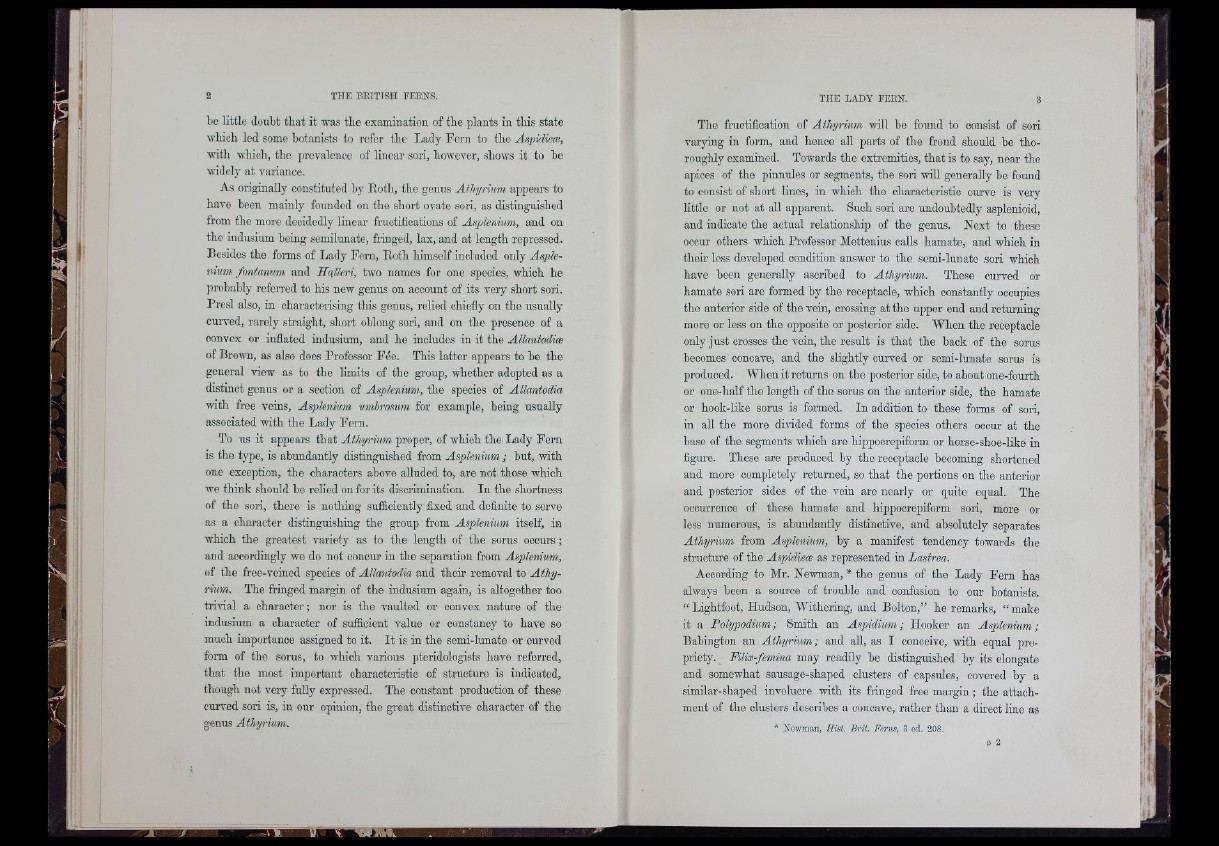
THE BBITISH EEENS. THE LADY FERN.
be little doubt that it was the examination of the plants in this state
which led some botanists to refer the Lady Fern to the Aspidieæ,
with which, the preyalenoe of linear sori, however, shows it to he
widely at variance.
As originally constituted by Roth, the genus Afhyrium appears to
have been mainly founded on the short ovate sori, as distinguished
from the more decidedly linear fructifications of Asplenium, and on
the indusium being somilunate, fringed, lax, and at length repressed.
Besides the forms of Lady Fern, Roth himself included only Asplenium
fontanum and Ilafleri, two names for one species, which he
probably referred to his new genus on account of its very short sori.
Presl also, in charaetorising this genus, relied chiefly on the usually
curved, rarely straight, short oblong sori, and on the presence of a
convex or inflated indusium, and he includes in it the Allantodioe
of Brown, as also does Professor Fée. This latter appears to he the
general view as to the limits of the group, whether adopted as a
distinct genus or a section of Asplenium, the species of Allantodia
with free veins, Asplenium xmlrosum for example, being usually
associated with the Lady Fern.
To us it appears that Atlixjrium proper, of which the Lady Fern
is the type, is abundantly distinguished from Asplenium ; hut, with
one exception, the characters above alluded to, are not those which
we think should he relied on for its discrimination. In the shortness
of the sori, there is nothing sufficiently fixed and definite to serve
as a character distinguishing the group from Asplenium itself, in
which the greatest variety as to the length of the sorus occurs ;
and accordingly we do not concur in the separation from Asplenium,
of the free-veined species of Allantodia and their removal to Athyrium.
The fringed margin of the indusium again, is altogether too
trivial a character; nor is the vaulted or convex nature of the
indusium a character of sufficient value or constancy to have so
much importance assigned to it. It is in the semi-lunate or curved
form of the sorus, to which various pteridologists have referred,
that the most important characteristic of structure is indicated,
though not very fully expressed. The constant production of these
curved sori is, in our opinion, the great distinctive character of the
genus Athyrium.
The fructification of Athyrium will he found to consist of sori
varying in form, and hence all parts of the frond should be thoroughly
oxaniined. Towards the extremities, that is to say, near the
apices of the pinnules or segments, the sori will generally he found
to consist of short lines, in which the characteristic curve is very
little or not at all apparent. Such sori are undoubtedly asplenioid,
and indicate the actual relationship of the genus. Next to these
occur others which Professor Mettenius calls hamate, and which in
their less developed condition answer to the semi-lunate sori which
have been generally ascribed to Athyrium. These curved or
hamate sori are formed by the receptacle, which constantly occupies
the anterior side of the vein, crossing at the upper end and returning
more or less on the opposite or posterior side. When the receptacle
only just crosses the vein, the result is that the hack of the sorus
becomes concave, and the slightly curved or semi-lunate sorus is
produced. When it returns on the posterior side, to about one-fourth
or one-half the length of the sorus on the anterior side, the hamate
or hook-like sorus is formed. In addition to these forms of sori,
in aU. the more divided forms of the species others occur at the
base of the segments which are hippoorepiform or horse-shoe-lOre in
figure. These are produced by the receptacle hecoming shortened
and more completely returned, so that the portions on the anterior
and posterior sides of the vein are nearly or quite equal. The
occurrence of these hamate and hippoorepiform sori, more or
less numerous, is abundantly distinctive, and absolutely separates
Athyrium from Asplenium, by a manifest tendency towards the
structure of the Aspidiecs as represented in Lastrea.
According to Mr. Newman, * the genus of the Lady Fern has
always been a source of trouble and confusion to our botanists.
“ Lightfoot, Hudson, Withering, and Bolton,” he remarks, “ make
it a Polxjpodium; Smith an Aspidium; Hooker an Asplenium;
Bahington an Athxjrium; and aU, as I conceive, with equal propriety.
Filix-femma may readily he distinguished by its elongate
and somewhat sausage-shaped clusters of capsules, covered by a
similar-shaped involucre with its fringed free margin; the attachment
of the clusters describes a concave, rather than a direct line as
* Newman, H is t B r i t Ferns, 3 ed. 208.
B 2
■i!il